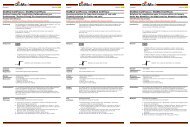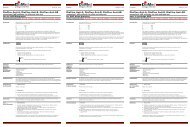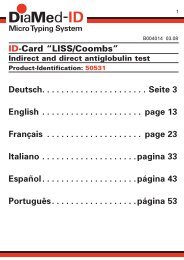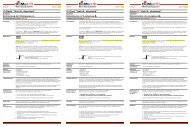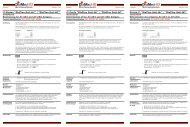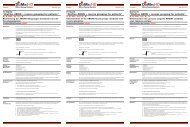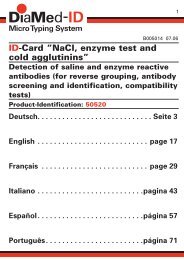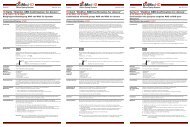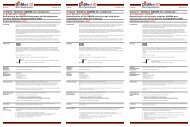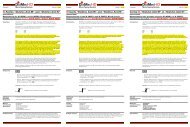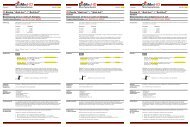OptiMAL Rapid Malaria Test OptiMAL Rapid Malaria Test OptiMAL ...
OptiMAL Rapid Malaria Test OptiMAL Rapid Malaria Test OptiMAL ...
OptiMAL Rapid Malaria Test OptiMAL Rapid Malaria Test OptiMAL ...
Create successful ePaper yourself
Turn your PDF publications into a flip-book with our unique Google optimized e-Paper software.
Deutsch B710000 01.06 English B710000 01.06 Français B710000 01.06<strong>OptiMAL</strong> <strong>Rapid</strong> <strong>Malaria</strong> <strong>Test</strong> <strong>OptiMAL</strong> <strong>Rapid</strong> <strong>Malaria</strong> <strong>Test</strong> <strong>OptiMAL</strong> <strong>Rapid</strong> <strong>Malaria</strong> <strong>Test</strong>EinleitungDer DiaMed <strong>OptiMAL</strong> <strong>Rapid</strong> <strong>Malaria</strong> <strong>Test</strong> eignet sich zum Nachweis einer Infektion mit Plasmodium species(<strong>Malaria</strong>) in einer Blutprobe und zeigt:IntroductionDiaMed <strong>OptiMAL</strong> <strong>Rapid</strong> <strong>Malaria</strong> <strong>Test</strong> is suitable for the detection of an infection by Plasmodium species (<strong>Malaria</strong>)in a blood sample, indicating:IntroductionDiaMed <strong>OptiMAL</strong> <strong>Rapid</strong> <strong>Malaria</strong> <strong>Test</strong> se prête à la détection d’une infection par Plasmodium species (<strong>Malaria</strong> ouPaludisme), indiquant:1) Vorhandensein oder Abwesenheit von Plasmodium sp.2) Differentialdiagnose von Plasmodium sp.:• P. falciparum (verantwortlicher Erreger tödlicher <strong>Malaria</strong>fälle)• P. vivax, P. malariae oder P. ovale1) Presence or absence of Plasmodium sp.2) Differential diagnosis of Plasmodium sp.:• P. falciparum (responsible agent of fatal cases of <strong>Malaria</strong>)• P. vivax, P. malariae or P. ovale1) La présence ou l’absence de Plasmodium sp.2) Le diagnostic différentiel de Plasmodium sp.:• P. falciparum (agent responsable des cas mortels de <strong>Malaria</strong>)• P.vivax, P. malariae ou P. ovaleDie Zahl der jährlich weltweit beobachteten <strong>Malaria</strong>fälle wird auf etwa 500 Millionen geschätzt, von denen etwa3 Millionen tödlich verlaufen, insbesondere bei Kindern und schwangeren Frauen.Each year, the number of cases of <strong>Malaria</strong> observed in the world is estimated at about 500 million, of which 3 millionprove fatal, particularly for children and pregnant women.Chaque année, le nombre de cas de <strong>Malaria</strong> observés dans le monde est estimé à près de 500 millions, dont prèsde 3 millions ont une issue fatale, en particulier chez l’enfant et la femme enceinte.Biomedizinische Eigenschaften von DiaMed <strong>OptiMAL</strong>:Bio-medical characteristics of DiaMed <strong>OptiMAL</strong>:Caractéristiques bio-médicales de DiaMed <strong>OptiMAL</strong>:Spezifität:Der <strong>Test</strong> weist das Vorhandensein von Plasmodium-Laktatdehydrogenase (pLDH) nach,einem Enzym, das sowohl in den geschlechtlichen als auch den ungeschlechtlichen Formendes Parasiten produziert wird. Das Vorhandensein von pLDH wird mit Hilfe monoklonalerAntikörper, die sich gegen Isoformen des Enzyms richten, nachgewiesen. Es gibt keineKreuzreaktion mit menschlicher LDH.Specificity:the test detects the presence of Plasmodium lactate dehydrogenase (pLDH), an enzymeproduced both in the sexual and asexual forms of the parasite. The presence of pLDH isrevealed using monoclonal antibodies directed against isoforms of the enzyme. There is nocross-reaction with the human LDH.Specificité:le test détecte la présence de lactate déhydrogénase de Plasmodium (pLDH), uneenzyme produite par les formes sexuées et asexuées du parasite. La présence de pLDH estrévélée par l’utilisation d’anticorps monoclonaux dirigés contre les isoformes de l’enzyme. Iln’y a pas de réaction croisée avec la LDH humaine.Empfindlichkeit:Der <strong>Test</strong> weist Parasitämie-Spiegel von 100-200 Parasiten pro µL Blut nach (entspricht einerParasitämie von 0,002% - 0,004%). Die Empfindlichkeit des DiaMed <strong>OptiMAL</strong> <strong>Rapid</strong> <strong>Malaria</strong><strong>Test</strong>s ist vergleichbar mit der mikroskopischen Beobachtung eines dünnen Blutausstrichsmit einem 100 x Immersionsobjektiv über einen Zeitraum von etwa 30 Minuten.Sensitivity:the test will detect parasitaemia levels of 100-200 parasites per µL of blood (correspondingto a parasitemia of 0.002% - 0.004%). The sensitivity of DiaMed <strong>OptiMAL</strong> <strong>Rapid</strong> <strong>Malaria</strong> <strong>Test</strong>can be compared with microscopic observation of a thin blood smear using a 100 x immersionobjective for a period of approximately 30 minutes.Sensibilité:le test permet de détecter une parasitémie de 100-200 parasites par µL de sang (résultatcorrespondant à une parasitémie de 0.002% à 0.004%). La sensibilité du DiaMed <strong>OptiMAL</strong><strong>Rapid</strong> <strong>Malaria</strong> <strong>Test</strong> peut être comparée à une observation microscopique d’au moins30 minutes d’un frottis sanguin mince avec un objectif x 100 à immersion.Einfach:Für den <strong>Test</strong> wird nur ein Tropfen Blut (10 µL) benötigt, das entweder kapillar direkt aus derFingerspitze oder aus antikoaguliertem Vollblut gewonnen wird.Easy: the test requires only one drop of blood (10 µL), either capillary collected directly from thefingertip or anti-coagulated whole blood.Simple:ce test nécessite une seule goutte de sang (10 µL) capillaire prélevé directement au bout dudoigt, ou de sang total anticoagulé.Schnell:Das Ergebnis liegt nach 20 Minuten vor.Fast:the result is obtained in 20 minutes.<strong>Rapid</strong>e:la réponse est obtenue en 20 minutes.Einsatz zur Überwachung von <strong>Malaria</strong>-Behandlungen:Der <strong>Test</strong> ist nur positiv, wenn die Parasiten im Blut vorhanden sind. Normalerweise wird er innerhalb von4-5 Tagen nach erfolgreicher Behandlung negativ.Aus diesem Grund ist der <strong>Test</strong> ein nützliches Hilfsmittel zum Nachweis solcher Stämme von Plasmodium species,die gegen bestimmte verschriebene Behandlungen resistent sind. Er kann im Rahmen posttherapeutischer Kontrolluntersuchungenzum Einsatz kommen.Eine Durchführung dieser Kontrolle alle 48 Stunden ist anzuraten: das anfänglich positive Signal (<strong>Test</strong> vor derBehandlung) wird sich bei der 2. Kontrolluntersuchung abschwächen und, wenn die Therapie erfolgreich war, beider 3. Kontrolle negativ sein.Use for the monitoring of <strong>Malaria</strong> treatment:The test is positive only when the parasites are present in the blood. It becomes negative usually within 4-5 daysfollowing successful treatment.Consequently, this test is useful to detect strains of Plasmodium species which are resistant to certain prescribedtreatments and may be part of a post-therapeutic control.It is advised to perform this control every 48 hours: the initial positive signal (test before treatment) will decreaseby the 2nd control and then will be negative by the 3rd control where therapy has been successful.Contrôle du traitement d’un accès palustre:Le test n’est positif que lorsque les parasites sont présents dans le sang circulant. Il se négative habituellementdans les 4-5 jours suivant un traitement efficace.Par conséquent, ce test peut être employé pour mettre en évidence des souches de Plasmodium sp. résistantes àcertains traitements et peut être utilisé dans le cadre d’un suivi post-thérapeutique.Il est souhaitable d’effectuer ce contrôle toutes les 48 heures: le signal positif avant le traitement diminuera lorsdu 2ème contrôle, puis sera négatif lors du 3ème contrôle en cas de succès thérapeutique.ReagenzienReagentsRéactifs<strong>OptiMAL</strong> <strong>Rapid</strong> <strong>Malaria</strong> <strong>Test</strong> . . . . . . . . . . . . . . . . . . . . . . . . . . Set für 48 <strong>Test</strong>s, enthaltend:DiaMed <strong>OptiMAL</strong> <strong>Test</strong>streifen . . . . . . . . . . . . . . . . . . . . . . . . . . . . . . . . . . . . . . 2 x 24 StückDiaMed <strong>OptiMAL</strong> Gefässe mit Konjugat . . . . . . . . . . . . . . . . . . . . . . . . . . . . . . . . . 48 StückDiaMed <strong>OptiMAL</strong> Gefässe mit Waschflüssigkeit . . . . . . . . . . . . . . . . . . . . . . . . . . 48 StückDiaMed <strong>OptiMAL</strong> Halter für Gefässe . . . . . . . . . . . . . . . . . . . . . . . . . . . . . . . . . . . . . 1 StückDiaMed <strong>OptiMAL</strong> Pufferlösung . . . . . . . . . . . . . . . . . . . . . . . . . . .2 Fläschchen mit 3.5 mLDiaMed <strong>OptiMAL</strong> Pipetten . . . . . . . . . . . . . . . . . . . . . . . . . . . . . . . . . . . . . . . . . . . . 48 Stück<strong>OptiMAL</strong> <strong>Rapid</strong> <strong>Malaria</strong> <strong>Test</strong> . . . . . . . . . . . . . . . . . . . . . . . . . . . . Kit for 48 test, containing:DiaMed <strong>OptiMAL</strong> Dipsticks . . . . . . . . . . . . . . . . . . . . . . . . . . . . . . . . . . . . . . . . 2 x 24 piecesDiaMed <strong>OptiMAL</strong> Conjugate wells . . . . . . . . . . . . . . . . . . . . . . . . . . . . . . . . . . . . . 48 piecesDiaMed <strong>OptiMAL</strong> Wash wells . . . . . . . . . . . . . . . . . . . . . . . . . . . . . . . . . . . . . . . . . 48 piecesDiaMed <strong>OptiMAL</strong> Well holder . . . . . . . . . . . . . . . . . . . . . . . . . . . . . . . . . . . . . . . . . . 1 pieceDiaMed <strong>OptiMAL</strong> Buffer . . . . . . . . . . . . . . . . . . . . . . . . . . . . . . . . . . . . . . . 2 vials of 3.5 mLDiaMed <strong>OptiMAL</strong> Pipettes . . . . . . . . . . . . . . . . . . . . . . . . . . . . . . . . . . . . . . . . . . . 48 pieces<strong>OptiMAL</strong> <strong>Rapid</strong> <strong>Malaria</strong> <strong>Test</strong> . . . . . . . . . . . . . . . . . . . . . . . . .Coffret de 48 tests, contenant:DiaMed <strong>OptiMAL</strong> Bandelettes . . . . . . . . . . . . . . . . . . . . . . . . . . . . . . . . . . . . . 2 x 24 piècesDiaMed <strong>OptiMAL</strong> Puits-conjugué . . . . . . . . . . . . . . . . . . . . . . . . . . . . . . . . . . . . . . 48 piècesDiaMed <strong>OptiMAL</strong> Puits-lavage . . . . . . . . . . . . . . . . . . . . . . . . . . . . . . . . . . . . . . . . 48 piècesDiaMed <strong>OptiMAL</strong> Support pour puits . . . . . . . . . . . . . . . . . . . . . . . . . . . . . . . . . . . . 1 pièceDiaMed <strong>OptiMAL</strong> Tampon . . . . . . . . . . . . . . . . . . . . . . . . . . . . . . . . . . .2 flacons de 3.5 mLDiaMed <strong>OptiMAL</strong> Pipettes . . . . . . . . . . . . . . . . . . . . . . . . . . . . . . . . . . . . . . . . . . . 48 piècesStabilität: siehe Verfallsdatum auf dem Etikett.Stability: see expiry date on label.Stabilité: voir date de péremption sur l’étiquette.Wichtig:Feuchtigkeit kann die Stabilität der Reagenzien herabsetzen. Aus diesem Grund ist esäußerst wichtig, nur die benötigte Anzahl <strong>Test</strong>streifen und Konjugatgefässe zu entnehmenund die Container danach sofort zu schließen.Important:the presence of humidity may decrease the stability of the reagents. So, it is very importantto remove the required number of Dipsticks and Conjugate wells and then to close immediatelythe containers.Important:la présence d’humidité peut diminuer la stabilité des réactifs. Il est donc très important deprendre le nombre de Bandelettes et Puits-conjugué nécessaires pour le test et de refermerensuite immédiatement les emballages.Achtung:Bei vorschriftsmäßigem Gebrauch stellen die Reagenzien des DiaMed <strong>OptiMAL</strong> <strong>Test</strong>s keinRisiko für den Benutzer dar. Kontakt mit Haut, Augen und Schleimhäuten im Rahmen normaler,guter Laborverfahren vermeiden. Reagenzien oder Blut nicht mit dem Mund pipettieren.Caution:when used as directed, DiaMed <strong>OptiMAL</strong> reagents present no risk to the user. Avoid contactwith skin, eyes and mucous membranes as part of normal good laboratory procedures. Donot pipette reagent or blood by mouth.Attention:lorsque les réactifs DiaMed <strong>OptiMAL</strong> sont utilisés comme indiqué, ils ne présentent aucunrisque pour l’utilisateur. Eviter tout contact avec la peau, les yeux et les muqueuses, fontpartie des procédures de bonne pratique des analyses de laboratoire. Ne pas pipeter à labouche un réactif ou du sang à tester.Positive Kontrolle(separat erhältlich)DiaMed <strong>OptiMAL</strong> Positive control, entspricht einem Signal, wie es bei einer Blutprobe mit einer geringenParasitämie (P.falciparum) von unter 1,0% erzielt wird.Es wird empfohlen, den positiven Kontrolltest bei jedem neuen <strong>Test</strong>-Set und außerdem immer dann anzuwenden,wenn geöffnete Container mit <strong>Test</strong>streifen und Konjugatbehältern mehr als eine Woche lang nicht mehr benutztwurden.Der Kontrolltest wird genauso benutzt wie die Blutprobe eines Patienten.Positive Control(available separately)DiaMed <strong>OptiMAL</strong> Positive control, corresponding to a signal obtained with a blood sample with a low parasiteamia(P.falciparum) inferior to 1.0%.It is recommended to use the positive control for each new kit and when opened containers of Dipsticks and Conjugatewells were not used for over one week.Use the control exactly like a patient blood sample.Contrôle positif(disponible séparément)DiaMed <strong>OptiMAL</strong> Positive control, correspondant à un signal obtenu avec un échantillon sanguin ayant uneparasitémie faible (P.falciparum) inférieure à 1.0%.Il est recommandé d‘utiliser le contrôle positif à chaque nouveau coffret et après ouverture des emballages, si lesBandelettes et les Puits-conjugué n’ont pas été utilisés pendant plus d’une semaine.Le contrôle s’utilise exactement comme un échantillon de sang de patient.Probenmaterial • Kapillarblut, entnommen aus der Fingerspitze. Siehe unten beschriebenes <strong>Test</strong>verfahren.• Frisches Blut, gewonnen durch Venenpunktion unter Verwendung von mit einem Antikoagulans (EDTA, Heparin)versehenen Probenröhrchen.Sample Material • Capillary blood collected from the fingertip. See test procedure below.• Fresh blood, collected by venipuncture, using sample tubes containing anticoagulant (EDTA, heparin).Echantillons • Du sang capillaire prélevé au bout du doigt, voir Procédure ci-dessous.• Du sang total prélevé selon les méthodes habituelles de prise de sang veineux, utiliser des tubes . . contenantun anticoagulant (EDTA, héparine).<strong>Test</strong>durchführungWerden die Reagenzien bei 2-8 °C gelagert, müssen sie vor ihrer Benutzung Raumtemperatur erreicht haben.Die Verpackung nach Entnahme der benötigten Anzahl Tauchstäbchen und Konjugatgefässe immer verschließen.<strong>Test</strong> procedureIf reagents are stored at 2-8 °C, allow to reach room temperature before use.Always close the containers after removing the required number of Dipsticks and Conjugate wells.MéthodeSi conservés à 2-8 °C, ramener les composants à température ambiante avant utilisation.Toujours fermer les emballages après avoir pris le nombre nécessaire de Bandelettes et de Puits avec conjugué.1. Ein <strong>Test</strong>streifen aus dem Container entnehmen und die Identifikation des Patienten auf das Etikett schreiben.(Hinweis: Den <strong>Test</strong>streifen immer am Etikett anfassen, nie das Reaktionsfeld berühren).2. 1 Gefäss mit Konjugat und 1 Gefäss mit Waschflüssigkeit in den Halter setzen.3. 1 Tropfen Pufferlösung (etwa 20 µL) in das Konjugatgefäss und 4 Tropfen (etwa 80 µL) in das Gefäss mit derWaschlflüssigkeit verteilen. 1 Minute lang stehen lassen.4. Die Hautoberfläche der Fingerspitze mit einem Desinfektionstupfer aseptisch reinigen, trocknen lassen undmit einer Lanzette in den seitlichen Bereich der Fingerspitze einstechen. Tupfer und sterile Lanzette in einemgeeigneten Abfallbehälter entsorgen.5. Eine Pipette nehmen und den Schlauch unter sanftem Druck auf dessen offenes Ende in den Blutstropfeneintauchen. Den Druck langsam nachlassen, um Blut in die Pipette einzusaugen. Bei der Verwendung vonvenösem Vollblut das Blut aus dem Entnahmeröhrchen in die Pipette saugen.6. 1 Tropfen Blut (etwa 10 µL) in das Konjugatgefäss geben. Mit dem Rührstab derselben Pipette (oberes Ende)vorsichtig umrühren. 1 Minute lang stehen lassen. (Pipette in einem geeigneten Abfallbehälter entsorgen).7. Den entsprechende <strong>Test</strong>streifen senkrecht in das Konjugatgefäss stellen und 10 Minuten lang im Gefäss belassen(das Blut wandert zur Filterfläche und der Kontrollstreifen wird allmählich sichtbar).8. Den <strong>Test</strong>streifen vom Konjugatgefäss in das Waschflüssigkeitsgefäss umsetzen und dort belassen, bis dasReaktionsfeld des <strong>Test</strong>streifen frei von Blut ist und die Kontrollbande deutlich sichtbar wird (innerhalb von5-10 Minuten).9. Den <strong>Test</strong>streifen aus dem Waschflüssigkeitsgefäss nehmen und die Reaktionen ablesen (Siehe ”Interpretationder Ergebnisse”).10. Den benutzten <strong>Test</strong>streifen als Referenz und die Überwachung im Anschluss an die Behandlung aufbewahren.1. Take a Dipstick from the container, write the patient’s identification on the label. (Note: always hold the Dipstickby the label, do not touch the reaction field).2. Place 1 Conjugate well and 1 Wash well in the Holder.3. Dispense 1 drop of Buffer (approximately 20 µL) into the Conjugate well and 4 drops (approximately 80 µL)into the Wash well. Allow to stand for 1 minute.4. Aseptically clean the skin surface of the fingertip with a Disinfectant Wad, let dry, prick the lateral part of thefingertip with a Lancet. Discard the Wad and the sterile Lancet into a suitable waste container.5. Take a Pipette, while gently squeezing the tube, immerse the open end in the blood drop and then gentlyrelease the pressure to draw blood into the Pipette. When using venous whole blood, draw blood from thecollection tube into the Pipette.6. Add 1 drop of blood (approximately 10 µL) into the Conjugate well. Mix gently with the stirrer of the samePipette (upper end). Allow to stand for 1 minute (Discard the Pipette into a suitable waste container).7. Place the appropriate Dipstick vertically into the Conjugate well and leave it in the well for 10 minutes (theblood migrates towards the filter pad and the control band will appear progressively).8. Transfer the Dipstick from the Conjugate well to the Wash well and leave it until the reaction field of the Dipstickis cleared of blood and the procedure control band becomes clearly visible (within 5-10 minutes).9. Remove the Dipstick from the Wash well and read the reactions (see “Interpretation of the results”).10. Keep the used Dipstick for future reference and post-treatment monitoring.1. Sortir une Bandelette du récipient, écrire l’identification du patient sur l’étiquette (NB: toujours tenir la Bandelettepar l’étiquette, ne pas toucher la zone de réaction).2. Placer 1 Puits-conjugué et 1 Puits-lavage dans le Support.3. Distribuer 1 goutte (environ 20 µL) de Tampon au Puits-conjugué et 4 gouttes (environ 80 µL) au Puits-lavage.Attendre 1 minute.4. Nettoyer la surface de la peau du doigt avec du Tampon désinfectant, laisser sécher puis piquer la partie latéraledu doigt avec une Lancette stérile (jeter le Tampon désinfectant et la Lancette dans une poubelleappropriée).5. Prendre une Pipette, presser doucement le tube et immerger l’extrémité ouverte dans la goutte de sang.Ensuite relâcher doucement la pression pour aspirer la goutte de sang dans la Pipette. Lors de prise de sangveineuse, préveler le sang avec la Pipette à partir du tube de prélèvement.6. Ajouter 1 goutte (environ 10 µL) de sang au Puits-conjugué. Mélanger doucement avec l’extrémité fermée dela même Pipette. Attendre 1 minute (jeter la Pipette dans une Poubelle appropriée).7. Placer la Bandelette verticalement dans le Puits-conjugué et la laisser dans le puits pendant 10 minutes (lesang montera vers le filtre et la ligne de contrôle apparaîtra progressivement).8. Transférer la Bandelette du Puits-conjugué au Puits-lavage et la laisser jusqu’à ce que le sang ne soit plus présentsur la zone de réaction et la ligne de contrôle soit clairement visible (durée: 5 à 10 minutes).9. Sortir la Bandelette du Puits-lavage et lire les réactions (voir “Interprétation du test”).10. Conserver la Bandelette testée comme référence ultérieure et pour le contrôle d’un suivi thérapeutique.
Français B710000 01.06 English B710000 01.06 Deutsch B710000 01.06Interprétation desrésultsA) PrincipeLe Puits-conjugué DiaMed <strong>OptiMAL</strong> contient un indicateur lié à un anticorps monoclonal(hybridome de souris) contre pLDH, séché à la surface. Cet anticorps monoclonal réagit avectoutes les iso-enzymes LDH du genre Plasmodium.Interpretation ofthe resultsA) PrincipleThe DiaMed <strong>OptiMAL</strong> Conjugate well contains an indicator-tagged monoclonal (mousehybridoma) antibody to pLDH, dried onto its surface. This monoclonal antibody reacts withall isoenzymes LDH of the genus Plasmodium.Interpretation derErgebnisseA) PrinzipDas DiaMed <strong>OptiMAL</strong> Konjugatgefäss enthält einen mit einem Indikator markierten, monoklonalenAntikörper (Maus-Hybridom) gegen pLDH, der in getrockneter Form auf dessenOberfläche aufgebracht wurde. Dieser monoklonale Antikörper reagiert mit allen LDH-Enzymendes Genus Plasmodium.Il y a 3 anticorps séchés sur la Bandelette DiaMed <strong>OptiMAL</strong>, sans l’ordre suivant:• anti-souris (de chèvre) comme contrôle de la procédure technique• Manti-pLDH (monoclonal) spécifique aux 4 espèces de Plasmodium sp. (falciparum,vivax, malariae, ovale)• anti-pLDH (monoclonal) spécifique à Plasmodium falciparumThere are 3 antibodies dried onto the DiaMed <strong>OptiMAL</strong> Dipstick, in following order:• Goat anti-mouse for the procedure control.• Monoclonal anti-pLDH specific to the 4 Plasmodium sp. (falciparum, vivax, malariae,ovale)• Monoclonal anti-pLDH specific to Plasmodium falciparum.Auf das DiaMed <strong>OptiMAL</strong> Tauchstäbchen wurden 3 getrocknete Antikörper in folgenderReihenfolge aufgebracht:• Ziege-Anti-Maus für die Verfahrenskontrolle.• Monoklonaler anti-pLDH, spezifisch für die 4 Plasmodium sp. (falciparum, vivax, malariae,ovale)• Monoklonaler anti-pLDH, spezifisch wirkend für Plasmodium falciparum.B) Validation du testLe test peut être considéré comme valable quand le sang n’est plus présent sur la zone de réaction de la Bandeletteet que la bande de contrôle est clairement visible, présentant une ligne dense. Dans ce cas, le résultat peutêtre interprêté.Le test est non valable dans 2 circonstances:1) Lorsque la bande de contrôle n’apparaît pas.2) Lorsque la Bandelette est insuffisamment lavée (la zone de réaction reste rouge); il se peut que le volume detampon était insuffisant ou le temps de lavage trop court.Dans les deux cas, ne pas interpréter les résultats. Répéter le test, en suivant exactement la méthode décrite.B) Validation of the testThe test can be considered valid when the reaction field of the Dipstick is cleared of blood and the control band isclearly visible, presenting a dense line. The results can be interpreted.The test is invalid in two cases:1) When the control band does not appear.2) When the Dipstick is not sufficiently cleared (reaction field remains red), the volume of buffer may have beeninsufficient or the washing time too short.In both cases, do not interpret results. Repeat the test, following exactly the test procedure.B) Überprüfung der Gültigkeit des <strong>Test</strong>sDer <strong>Test</strong> ist als gültig anzusehen, wenn das Blut vom Reaktionsfeld des <strong>Test</strong>streifens verschwunden ist und dieKontrollbande deutlich sichtbar ist und eine kräftige Linie bildet. Die Ergebnisse sind interpretierbar.Der <strong>Test</strong> ist in den folgenden beiden Fällen ungültig:1) Wenn die Kontrollbande nicht erscheint.2) Wenn der <strong>Test</strong>streifen nicht ausreichend gereinigt wird (Reaktionsfeld bleibt rot). In diesem Fall war das Volumender Pufferlösung nicht ausreichend oder die Waschzeit zu kurz.In beiden Fällen dürfen die Ergebnisse nicht interpretiert werden. Den <strong>Test</strong> wiederholen und dabei das <strong>Test</strong>verfahrengenau befolgen.C) Interprétation des résultatsRéaction positive: la pLDH présente dans l’échantillon réagit avec l’anti-pLDH conjugué et migre sur la Bandeletteoù elle sera capturée par l’un ou les deux anticorps spécifiques contre pLDH, provoquant l’apparition d’unebande colorée.C) Interpretation of the resultsPositive reaction: the pLDH present in the sample reacts with the anti-pLDH conjugate and rises up the Dipstickwhere it is captured by one or both of the specific pLDH antibodies, causing the appearance of a coloured band.C) Interpretation der ErgebnissePositive Reaktion: Die in der Blutprobe vorhandene pLDH reagiert mit dem anti-pLDH-Konjugat und steigt am<strong>Test</strong>streifen auf, wo sie von einer oder beiden der pLDH-spezifischen Antikörper aufgefangen wird. Dies verursachtdas Erscheinen eines farbigen Bandes.Réaction négative: la pLDH n’est pas détectée dans l’échantillon. Aucune réaction n’a eu lieu avec les anticorpscontre pLDH et seule la bande de contrôle sera visible.Negative reaction: no pLDH is detected in the sample. No reaction occurs with the pLDH antibodies and onlythe control band will be visible.Negative Reaktion: In der Blutprobe wird keine pLDH nachgewiesen. Es findet keine Reaktion mit den pLDH-Antikörpern statt und es ist nur das Kontrollband sichtbar.D) Modèle des réactionsD) Reaction patternD) ReaktionsmusterPositif pourP. falciparumPositif pourP. vivax/P. malariaeP. ovaleNégatif <strong>Test</strong> non valable <strong>Test</strong> non valablePositive forP. falciparumPositive forP. vivax/P. malariaeP. ovaleNegative Invalid InvalidPositiv fürP. falciparumPositiv fürP. vivax/P. malariaeP. ovaleNegativ Ungültig UngültigE) Suivi post-thérapeutiqueRépéter le test après 2 jours de traitement (48 heures)* puis à nouveau 2-3 jours plus tard* et comparer les réactionsobtenues à celles du test avant le traitement:• peu ou pas de différence des réactions: —> indique un traitement inefficaceE) Monitoring of treatment2 days (48 hours)* after the beginning of the treatment. and again 2-3 days* later, repeat testing and compare thereactions with the result obtained before the treatment.• little or no difference of reactions: —> indicates inefficient treatmentE) Behandlungsüberwachung2 Tage (48 Stunden)* nach Beginn der Behandlung und nochmals 2-3 Tage* später das <strong>Test</strong>verfahren wiederholenund die Reaktionen mit dem vor der Behandlung erzielten Ergebnis vergleichen.• Geringer oder kein Unterschied bei den Reaktionen: —> Hinweis auf unwirksame Behandlung• diminution de la réaction positive après 2 jourset résultat négatif au 4-5ème jour:—> indique un traitement efficace• weakened positive reaction after 2 daysand negative reaction after 4-5 days:—> indicates efficient treatment• Abgeschwächte positive Reaktion nach 2 Tagenund negative Reaktion nach 4-5 Tagen:—> Hinweis auf wirksame Behandlung* Remarque: cette durée peut être plus longue selon le traitement utilisé. Dans ce cas, répéter le contrôle7 et 10 jours après le début du traitement. Si la réaction reste positive avec la même intensitédu 5ème au 10ème jour, la possibilité d‘une souche de Plasmodium sp. résistante autraitement doit être évoquée.* Remark: Depending on the medication used, the treatment may take longer. In this case, repeat thecontrol 7 and 10 days after the start of the treatment. If the reaction of the test remainspositive with the same intensity after 5-10 days, the possibility of a resistant strain has to beconsidered.* Anmerkung: Je nach angewendeter Medikation kann die Behandlung auch länger dauern. In diesem Falldie Kontrolluntersuchung 7 und 10 Tage nach Beginn der Behandlung wiederholen. Wenndie <strong>Test</strong>reaktion nach 5-10 Tagen mit der gleichen Intensität positiv bleibt, ist die Möglichkeiteines resistenten Stamms in Betracht zu ziehen.Limites • Toutes modifications des procédures décrites ci-dessus ou l’utilisation d’autres réactifs peuvent influencer lesrésultats et rendre le test non valable.• Ne pas mélanger et utiliser des réactifs, Bandelettes et Puits-conjugués de différents lots.• Ne pas oublier que le résultat du test DiaMed-<strong>OptiMAL</strong> doit être interprété en tenant compte du contexte épidémiologique,clinique et thérapeutique. Quand cela semble être indiqué, le recours aux techniques parasitologiquesde référence (examen au microscope d’une goutte épaisse et d’un frottis sanguin mince) devrait êtreconsidéré.Limitations • Any modifications to the above procedures or use of other reagents will invalidate the test procedure.• The reagents, Dipsticks and Conjugate wells of different lots must not be mixed and used.• Remember that the result of DiaMed-<strong>OptiMAL</strong> test is to be interpreted within the epidemiological, clinical andtherapeutical context. When it seems indicated, the parasitological techniques of reference should be considered(microscopical examination of the dick smears and thin blood films).Einschränkungen • Jegliche Abweichungen von den oben beschriebenen Verfahren oder die Verwendung anderer Reagenzienmachen das <strong>Test</strong>verfahren ungültig.• Reagenzien, <strong>Test</strong>streifen und Konjugatbehälter unterschiedlicher Chargen dürfen nicht miteinander vermischtund zusammen verwendet werden.• Es ist zu beachten, dass das DiaMed-<strong>OptiMAL</strong> <strong>Test</strong>resultat im Zusammenhang mit den Epidemiologie-, KlinikundTherapie-Daten interpretiert werden soll. Wenn es angezeigt scheint, sollte eine parasitologische Referenztechnikberücksichtigt werden (mikroskopische Untersuchung von dicken Tropfen und Blutausstrich).Bibliographie1. Makler M.T., Pamer C.J. and Ager A.L.: A review of practical techniques for the diagnosis of malaria. Ann.Trop. Med & Parasitol. 1998, 92 (4), 419-4332. Palmer C.J., Lindo J.F., Klaskala W.I., Quesada J.A., Kaminsky R., Baum M.K., Ager A.L.: Evaluation of the Opti-MAL test for rapid diagnosis of Plasmodium vivax and Plasmodium falciparum malaria.J Clin. Microbiol, 1998 Jan. 36(1): 203-6.3. Quintana M., R. Piper, H.-L. Boling, M. Makler, C. Sherman, E. Gill, E. Fernandez, S. Martin: <strong>Malaria</strong> diagnosisby dipstick assay in a honduran population with codendemic Plasmodium falciparum and Plasmodium vivax.Am.J.Trop.Med.Hyg., 1998, 59(6):868-871.4. Moody A., Hunt-Cooke A., Gabette E. and Chiodini P.: Performance of the <strong>OptiMAL</strong> malaria antigen capturedipstick for malaria diagnosis and treatment monitoring at the Hospital for Tropical Diseases, London. BritishJournal of Haematol. 2000, 109, 891-894.Bibliography1. Makler M.T., Pamer C.J. and Ager A.L.: A review of practical techniques for the diagnosis of malaria. Ann.Trop. Med & Parasitol. 1998, 92 (4), 419-4332. Palmer C.J., Lindo J.F., Klaskala W.I., Quesada J.A., Kaminsky R., Baum M.K., Ager A.L.: Evaluation of the Opti-MAL test for rapid diagnosis of Plasmodium vivax and Plasmodium falciparum malaria. J Clin. Microbiol, 1998Jan. 36(1): 203-6.3. Quintana M., R. Piper, H.-L. Boling, M. Makler, C. Sherman, E. Gill, E. Fernandez, S. Martin: <strong>Malaria</strong> diagnosisby dipstick assay in a honduran population with codendemic Plasmodium falciparum and Plasmodium vivax.Am.J.Trop.Med.Hyg., 1998, 59(6):868-871.4. Moody A., Hunt-Cooke A., Gabette E. and Chiodini P.: Performance of the <strong>OptiMAL</strong> malaria antigen capturedipstick for malaria diagnosis and treatment monitoring at the Hospital for Tropical Diseases, London. BritishJournal of Haematol. 2000, 109, 891-894.Literatur1. Makler M.T., Pamer C.J. and Ager A.L.: A review of practical techniques for the diagnosis of malaria. Ann.Trop. Med & Parasitol. 1998, 92 (4), 419-4332. Palmer C.J., Lindo J.F., Klaskala W.I., Quesada J.A., Kaminsky R., Baum M.K., Ager A.L.: Evaluation of the Opti-MAL test for rapid diagnosis of Plasmodium vivax and Plasmodium falciparum malaria. J Clin. Microbiol, 1998Jan. 36(1): 203-6.3. Quintana M., R. Piper, H.-L. Boling, M. Makler, C. Sherman, E. Gill, E. Fernandez, S. Martin: <strong>Malaria</strong> diagnosisby dipstick assay in a honduran population with codendemic Plasmodium falciparum and Plasmodium vivax.Am.J.Trop.Med.Hyg., 1998, 59(6):868-871.4. Moody A., Hunt-Cooke A., Gabette E. and Chiodini P.: Performance of the <strong>OptiMAL</strong> malaria antigen capturedipstick for malaria diagnosis and treatment monitoring at the Hospital for Tropical Diseases, London. BritishJournal of Haematol. 2000, 109, 891-894.Produits <strong>OptiMAL</strong> <strong>Rapid</strong> <strong>Malaria</strong> <strong>Test</strong> (ID-no: 46050) Coffret de 48 tests . . . . . . . . . . . . . . . . . . . . . . .REF 710000<strong>OptiMAL</strong> Contrôle positif (ID-no: 13200) 1 x 8 puits . . . . . . . . . . . . . . . . . . . . . . .REF 710011Products <strong>OptiMAL</strong> <strong>Rapid</strong> <strong>Malaria</strong> <strong>Test</strong> (ID-no: 46050) kit for 48 tests . . . . . . . . . . . . . . . . . . . . . . .REF 710000<strong>OptiMAL</strong> Positive control (ID-no: 13200) 1 x 8 wells . . . . . . . . . . . . . . . . . . . . . . .REF 710011Produkte <strong>OptiMAL</strong> <strong>Rapid</strong> <strong>Malaria</strong> <strong>Test</strong> (ID-no: 46050) Set für 48 <strong>Test</strong>s . . . . . . . . . . . . . . . . . . . . . . .REF 710000<strong>OptiMAL</strong> Positive control (ID-no: 13200) 1 x 8 Reaktionsgefässe . . . . . . . . . . . . . . . . . . . . . . .REF 710011Ces produits sont garantis quant à leurs propriétés et qualités stipulées sur l’étiquette et dans le mode opératoire.Le fabricant décline toute responsabilité pour les cas où ces produits seraient employés ou vendus à d’autresusages.These products are guaranteed to perform as described on the label and in the instruction sheet. The manufacturerdeclines all responsibility arising out of the use or sale of these products in any way or for any purpose otherthan those described therein.Für diese Produkte wird nur Garantie übernommen, wenn sie gemäss den Angaben auf dem Etikett und derAnwendungsvorschrift verwendet werden. Jegliche Verantwortung wird ausdrücklich abgelehnt, wenn das Präparatfür andere Zwecke gebraucht oder verkauft wird.DiaMed SA, 1785 Cressier s/Morat, Suisse DiaMed AG, 1785 Cressier s/Morat, Switzerland DiaMed AG, 1785 Cressier s/Morat, Schweiz
Italiano B710000 01.06 Español B710000 01.06 Português B710000 01.06<strong>OptiMAL</strong> <strong>Rapid</strong> <strong>Malaria</strong> <strong>Test</strong> <strong>OptiMAL</strong> <strong>Rapid</strong> <strong>Malaria</strong> <strong>Test</strong> <strong>OptiMAL</strong> <strong>Rapid</strong> <strong>Malaria</strong> <strong>Test</strong>IntroduzioneDiaMed <strong>OptiMAL</strong> <strong>Rapid</strong> <strong>Malaria</strong> <strong>Test</strong> è indicato per l’individuazione di un’infezione da plasmodi della malaria inun campione di sangue, ed è in grado di determinare:IntroducciónLa prueba DiaMed <strong>OptiMAL</strong> <strong>Rapid</strong> <strong>Malaria</strong> <strong>Test</strong> està indicada para detectar la infección por distintas Plasmodium(malaria) en una muestra de sangre, e indica:IntroduçãoO DiaMed <strong>OptiMAL</strong> <strong>Rapid</strong> <strong>Malaria</strong> <strong>Test</strong> é adequado para detecção de infecção por Plasmodium species (malária)numa amostra sanguínea, indicando:1) Presenza o assenza di Plasmodi2) Diagnosi differenziale delle diverse specie di Plasmodium:• P. falciparum (agente responsabile di casi mortali di malaria)• P. vivax, P. malariae o P. ovale1) Presencia o ausencia de especies Plasmodium2) Permite un diferencial de las especies Plasmodium:• P. falciparum (agente responsable de los casos mortales de malaria)• P. vivax, P. malariae o P. ovale1) Presença ou ausência de Plasmodium sp.2) Diagnóstico diferencial de Plasmodium sp.:• P. falciparum (agente responsável por casos fatais de malária)• P. vivax, P. malariae ou P. ovaleE’stimato che ogni anno nel mondo vi siano 500 milioni di nuovi casi di malaria, di cui 3 milioni ad esito letale,soprattutto in donne in gravidanza e bambini.El número de casos anuales de paludismo en el mundo se estima en unos 500 millones, de los cuales 3 millonesprovocan la muerte, en particular entre niños y mujeres embarazadas.O número de casos de malária observados todos os anos a nível mundial é calculado em 500 milhões, dos quais3 milhões são fatais, particularmente no caso de crianças e mulheres grávidas.Caratteristiche biomedicali di DiaMed <strong>OptiMAL</strong>:Características biomédicas de DiaMed <strong>OptiMAL</strong>:Características biomédicas do DiaMed <strong>OptiMAL</strong>:Specificità:il test rileva la presenza di lattato deidrogenasi (pLDH) liberata dai plasmodi, unenzima prodotto sia dalle forme sessuate che da quelle asessuate del parassita. La presenzadi pLDH è evidenziata utilizzando anticorpi monoclonali diretti contro lquesto enzima. Non simanifesta nessuna reazione crociata con l’LDH umana.Especificidad:La prueba detecta la presencia de lactato deshidrogenasa de Plasmodium (pLDH), unenzima producida tanto en las formas sexuadas como asexuadas del parásito. La presenciade pLDH se detecta utilizando anticuerpos monoclonales dirigidos contra isoformas de estaenzima. No existe reacción cruzada con la LDH humana.Especificidade:o teste detecta a presença de lactato desidrogenase de Plasmodium (pLDH), umaenzima produzida pelas formas sexuadas e assexuadas do parasita. A presença de pLDHé revelada utilizando anticorpos monoclonais dirigidos contra isoformas da enzima. Nãoexiste reacção cruzada com a LDH humana.Sensibilità:il test è in grado di individuare livelli di parassitemia di 100-200 parassiti per µL di sangue(0,002% - 0,004%). La sensibilità del DiaMed <strong>OptiMAL</strong> <strong>Rapid</strong> <strong>Malaria</strong> <strong>Test</strong> può essere paragonataall’osservazione al microscopio di uno striscio sottile di sangue utilizzando un obiettivo100 X a immersione per circa 30 minuti.Sensibilidad:La prueba detecta niveles de parasitemia de 100-200 parásitos por µL de sangre (lo que correspondea una parasitemia del 0,002% - 0,004%). La sensibilidad de DiaMed <strong>OptiMAL</strong> <strong>Rapid</strong><strong>Malaria</strong> <strong>Test</strong> puede compararse con la observación al microscopio de un frotis sanguíneocon técnica de gota fina utilizando un objetivo de inmersión de 100 aumentos durante unperiodo de unos 30 minutos.Sensibilidade:o teste detecta níveis de parasitemia de 100-200 parasitas por µL de sangue (correspondentesa uma parasitemia de 0,002% - 0,004%). A sensibilidade do DiaMed <strong>OptiMAL</strong> <strong>Rapid</strong><strong>Malaria</strong> <strong>Test</strong> pode ser comparada a uma observação microscópica de um esfregaço fino desangue com uma objectiva de imersão de 100 x durante um período aproximado de30 minutos.Semplice:il test richiede una sola goccia di sangue (10 µL), prelevato direttamente dai capillari delpolpastrello o da sangue intero non coagulato.Facilidad:La prueba sólo requiere una gota de sangre (10 µL), ya sea sangre capilar obtenida directamenteen la yema del dedo o sangre total con anticoagulante.Fácil: o teste necessita apenas de uma gota de sangue (10 µL), capilar ou colhido directamente daponta do dedo, ou sangue total com anticoagulante.<strong>Rapid</strong>o:il risultato si ottiene in 20 minuti.<strong>Rapid</strong>ez:El resultado se obtiene en 20 minutos.Rápido:o resultado é obtido em 20 minutos.Impiego per il monitoraggio del trattamento anti-malarico:Il test è positivo soltanto in caso di presenza di parassiti nel sangue. Diventa negativo di solito 4-5 giorni dopo untrattamento efficace.Per tale motivo, il test risulta utile per individuare ceppi di plasmodi resistenti a determinati trattamenti prescritti epuò fare parte di un controllo post-terapeutico.Si consiglia di eseguire il controllo ogni 48 ore: la positività iniziale (test prima del trattamento) diminuisce al2° controllo. Il test risulterà poi negativo al 3° controllo, qualora la terapia abbia avuto esito positivo.Uso para el seguimiento del tratamiento antipalúdico:La prueba sólo es positiva si existe presencia de parásitos en la sangre. Generalmente, si el tratamiento tieneéxito la prueba se negativizará a los 4-5 días.Por consiguiente, esta prueba es útil para detectar cepas de especies de Plasmodium resistentes a determinadostratamientos, y puede usarse como control posterapéutico.Se recomienda realizar este control cada 48 horas: el resultado positivo inicial (prueba anterior al tratamiento) disminuiráel en segundo control y se negativizará en el tercero, siempre que el tratamiento haya tenido éxito.Utilização na monitorização do tratamento da malária:O teste só é positivo quando existem parasitas presentes no sangue. Normalmente fica negativo em 4-5 dias apóstratamento bem sucedido.Por conseguinte, este teste é útil na detecção de estirpes de Plasmodium sp. resistentes a certos medicamentossujeitos a receita, podendo fazer parte de um controlo pós-tratamento.Recomenda-se a realização deste controlo todas as 48 horas: no caso de terapia bem sucedida, o sinal positivoinicial (teste antes do tratamento) irá diminuir no 2º controlo e passar a negativo no 3º controlo.ReagentiReactivosReagentes<strong>OptiMAL</strong> <strong>Rapid</strong> <strong>Malaria</strong> <strong>Test</strong> . . . . . . . . . . . . . . . . . . . . . . . . . . . Kit per 48 test, contenente:DiaMed <strong>OptiMAL</strong> strisce (dipsticks). . . . . . . . . . . . . . . . . . . . . . . . . . . . . . . . . . 2 x 24 pezziDiaMed <strong>OptiMAL</strong> pozzetti di coniugato . . . . . . . . . . . . . . . . . . . . . . . . . . . . . . . . . . 48 pezziDiaMed <strong>OptiMAL</strong> pozzetti di lavaggio . . . . . . . . . . . . . . . . . . . . . . . . . . . . . . . . . . . 48 pezziDiaMed <strong>OptiMAL</strong> supporto per pozzetti . . . . . . . . . . . . . . . . . . . . . . . . . . . . . . . . . . 1 pezzoDiaMed <strong>OptiMAL</strong> soluzione tampone . . . . . . . . . . . . . . . . . . . . . . . . . . . . 2 fiale da 3.5 mLDiaMed <strong>OptiMAL</strong> pipette . . . . . . . . . . . . . . . . . . . . . . . . . . . . . . . . . . . . . . . . . . . . . 48 pezzi<strong>OptiMAL</strong> <strong>Rapid</strong> <strong>Malaria</strong> <strong>Test</strong> . . . . . . . . . . . . . . . . . . . . Equipo para 48 pruebas, contiente:DiaMed <strong>OptiMAL</strong> Tiras reactivas . . . . . . . . . . . . . . . . . . . . . . . . . . . . . . . . .2 x 24 unidadesDiaMed <strong>OptiMAL</strong> Pocillos de conjugado . . . . . . . . . . . . . . . . . . . . . . . . . . . . . 48 unidadesDiaMed <strong>OptiMAL</strong> Pocillos de lavado . . . . . . . . . . . . . . . . . . . . . . . . . . . . . . . . . 48 unidadesDiaMed <strong>OptiMAL</strong> Soporte para pocillos . . . . . . . . . . . . . . . . . . . . . . . . . . . . . . . . .1 unidadDiaMed <strong>OptiMAL</strong> Tampón . . . . . . . . . . . . . . . . . . . . . . . . . . . . . . . . . . .2 frascos de 3.5 mLDiaMed <strong>OptiMAL</strong> Pipetas . . . . . . . . . . . . . . . . . . . . . . . . . . . . . . . . . . . . . . . . . . 48 unidades<strong>OptiMAL</strong> <strong>Rapid</strong> <strong>Malaria</strong> <strong>Test</strong> . . . . . . . . . . . . . . . . . . . . . . . . . . . .Kit de 48 testes, contendo:DiaMed <strong>OptiMAL</strong> Tiras reactivas . . . . . . . . . . . . . . . . . . . . . . . . . . . . . . . . . . . .2 x 24 peçasDiaMed <strong>OptiMAL</strong> Poços de conjugado . . . . . . . . . . . . . . . . . . . . . . . . . . . . . . . . . .48 peçasDiaMed <strong>OptiMAL</strong> Poços de lavagem . . . . . . . . . . . . . . . . . . . . . . . . . . . . . . . . . . .48 peçasDiaMed <strong>OptiMAL</strong> Suporte de poço . . . . . . . . . . . . . . . . . . . . . . . . . . . . . . . . . . . . . . .1 peçaDiaMed <strong>OptiMAL</strong> Tampão . . . . . . . . . . . . . . . . . . . . . . . . . . . . . . . . . . .2 frascos de 3.5 mLDiaMed <strong>OptiMAL</strong> Pipetas . . . . . . . . . . . . . . . . . . . . . . . . . . . . . . . . . . . . . . . . . . . . .48 peçasStabilità: vedere la data di scadenza sull‘etichetta.Estabilidad: véase fecha de caducidad en la etiqueta.Estabilidade: ver prazo de validade no rótulo.la presenza di umidità può ridurre la stabilità dei reagenti. E’pertanto estremamente im-portante richiudere immediatamente le confezioni dopo avere prelevato la quantità necessariadi strisce e di pozzetti di coniugato.Avvertenzaimportante:Importante:la presencia de humedad puede disminuir la estabilidad de los reactivos. Por ello es muyimportante sacar el número necesario de bastoncillos y pocillos de conjugado y a continuacióncerrar inmediatamente los envases.Importante:a presença de humidade pode fazer diminuir a estabilidade dos reagentes. Por conseguinte,é de extrema importância retirar o número necessário de tiras reactivas e de poços de conjugadoe em seguida fechar imediatamente os recipientes,Attenzione:se utilizzati come prescritto, i reagenti DiaMed <strong>OptiMAL</strong> non presentano alcun rischio perl’utilizzatore. Evitare il contatto con la pelle, gli occhi e le mucose, seguire le precauzioniutilizzate in laboratorio; non pipettare reagenti o sangue con la bocca.Precaución:si se usan según las instrucciones, los reactivos DiaMed <strong>OptiMAL</strong> no presentan peligro parael usuario. Evite el contacto con la piel, los ojos y las mucosas, como parte de las prácticascorrectas de laboratorio. No pipetee reactivos ni sangre con la boca.Atenção:quando utilizados de acordo com as instruções, os reagentes DiaMed <strong>OptiMAL</strong> não representamperigo para o utilizador. Evite o contacto com a pele, olhos e membranas mucosas,como parte das boas práticas laboratoriais. Não pipete reagentes nem sangue com a boca.Controllo positivo(disponibilie separatamente)DiaMed <strong>OptiMAL</strong> Positive control, corrispondente a un segnale ottenuto con un campione di sangue a bassaparassitemia (P.falciparum), inferiore a 1,0%.Si raccomanda di utilizzare il controllo positivo con ogni nuovo kit e quando le strisce e i pozzetti per coniugatonon siano utilizzati da oltre una settimana.Utilizzare il controllo esattamente comse si trattasse di un campione di sangue umano.Control positivo(disponible porseparado)DiaMed <strong>OptiMAL</strong> control positivo, la reacción obtenida corresponde a una muestra de sangre con una parasitemiabaja (P.falciparum) inferior al 1,0%.Se recomienda emplear el control positivo para cada nuevo kit y siempre que un envase de bastoncillos opocillos de conjugado ya abierto no se haya utilizado durante más de una semana.Utilice el control exactamente como una muestra de sangre del paciente.Controlo positivo(disponibilizado emseparado)DiaMed <strong>OptiMAL</strong> Positive control, correspondente a um sinal obtido com uma amostra de sangue de baixaparasitemia (P.falciparum), inferior a 1,0%.Recomenda-se a utilização do controlo positivo em cada kit novo e quando recipientes abertos de tiras reactivas epoços de conjugado não tenham sido usados há mais de uma semana.Utilize o controlo exactamente como uma amostra de doente.Campioni • Sangue capillare prelevato dal polpastrello. Vedere la procedura oltre descritta.• Sangue fresco, raccolto mediante prelievo venoso, utilizzando provette contenenti anticoagulante (EDTA, eparina).Muestra • Sangre capilar tomada de la yema del dedo. Consulte el procedimiento de la prueba descrito a continuación.• Sangre fresca obtenida por venopunción utilizando tubos de muestra con anticoagulante (EDTA, heparina).Amostras • Sangue capilar colhido da ponta do dedo. Ver procedimento de teste, abaixo.• Sangue fresco, colhido por punção venosa, utilizando tubos de amostra contendo anticoagulante (EDTA,heparina).ProceduraSe i reagenti sono stati conservati a 2-8 °C, portarli a temperatura ambiente prima dell’uso.Richiudere sempre i recipienti dopo avere prelevato la quantità necessaria di strisce e di pozzetti di coniugato.Procedimiento de lapruebaSi los reactivos se conservan entre 2-8 °C, deje que alcancen la temperatura ambiente antes de utilizarlos.Cierre siempre los envases después de sacar el número necesario de tiras reactivas y pocillos de conjugado.Procedimento dotesteSe os reagentes estiverem conservados entre 2-8 °C, deixe-os atingirem a temperatura ambiente antes de utilizar.Feche sempre os recipientes depois de ter retirado o número necessário de tiras reactivas e de poços de conjugado.1. Prelevare una striscia della confezione, scrivere l’identificazione del paziente sull’etichetta. (Nota: tenere semprela striscia dalla parte dell’etichetta, non toccare il campo di reazione).2. Collocare sul supporto 1 pozzetto di coniugato e 1 pozzetto di lavaggio.3. Pipettare 1 goccia di soluzione tampone (circa 20 µL) nel pozzetto del coniugato e 4 gocce (circa 80 µL) nelpozzetto di lavaggio. Attendere 1 minuto.4. Disinfettare il polpastrello del paziente con una apposita gaza, lasciare asciugare, pungere lateralmente il polpastrellocon una lancetta. Gettare il rifiuti in apposito contenitore.5. Prendere una pipetta, premerla delicatamente immergendo l’estremità aperta nella goccia di sangue, quindiridurre lentamente la pressione per prelevare il sangue all’interno della pipetta. Se si utilizza sangue interovenoso, pipettare il sangue della provetta.6. Aggiungere 1 goccia di sangue (circa 10 µL) nel pozzetto di coniugato. Miscelare delicatamente con l’estremitàrigida della pipetta stessa (estremità superiore). Attendere 1 minuto. (Gettare la pipetta nell’apposito contenitoreper rifiuti).7. Collocare la striscia verticalmente all’interno del pozzetto di coniugato e lasciarvela per 10 minuti (il sanguemigrerà lungo la striscia, rendendo progressivamente visibile la banda di controllo).8. Trasferire la striscia dal pozzetto di coniugato nel pozzetto di lavaggio e lasciarvela fino a quando il campo direazione della striscia risulterà pulito dal sangue, e la banda di controllo diventerà chiaramente visibile(5-10 minuti).9. Togliere la striscia dal pozzetto di lavaggio e leggere le reazioni (vedere “Interpretazione dei risultati”).10. Conservare la striscia usata per futuro riferimento e per il monitoraggio post-terapeutico.1. Tome una tira reactiva del envase y escriba el nombre o identificación del paciente en la etiqueta.(Nota: sujete siempre las tiras por la etiqueta, sin tocar la zona de reacción).2. Coloque 1 pocillo de conjugado y 1 pocillo de lavado en el soporte.3. Pipetee 1 gota de tampón (aproximadamente 20 µL) en el pocillo de conjugado y 4 gotas (aproximadamente80 µL) en el pocillo de lavado. Deje reposar 1 minuto.4. Limpie de forma aséptica la superficie de la yema del dedo con el apósito desinfectante y efectúe una puncióncon la lanceta en el lateral de la yema. Deseche el apósito y la lanceta en un recipiente de residuos adecuado.5. Tome una pipeta apretando suavemente el tubo, sumerja el extremo abierto en la gota de sangre y a continuaciónrelaje suavemente la presión para aspirar sangre con la pipeta. Si utiliza sangre venosa completa,aspire la sangre con la pipeta del tubo de recogida de muestra.6. Añada 1 gota de sangre (aproximadamente 10 µL) en el pocillo de conjugado. Mezcle suavemente con elextremo superior de la misma pipeta. Deje reposar la mezcla 1 minuto (deseche la pipeta y depositelo en unrecipiente adecuado para residuos ).7. Introduzca la tira reactiva correspondiente en el pocillo de conjugado y déjelo allí 10 minutos (la sangremigrará a través del papel de filtro, y la banda control se visualizará progresivamente).8. Transfiera la tira reactiva desde el pocillo de conjugado al pocillo de lavado y déjelo allí hasta que la zona dereacción de la tira reactiva quede limpia de sangre y la banda control sea claramente visible (unos 5-10 minutos).9. Retire la tira reactiva del pocillo de lavado y observe las reacciones (véase “Interpretación de los resultados”).10. Conserve la tira reactiva usada como referencia y seguimiento posterior al tratamiento.1. Tire uma fita reactiva do recipiente, escreva a identificação do doente no rótulo. (Nota: segure sempre a fitareactiva pelo rótulo, não toque no campo de reacção).2. Coloque 1 poço de Conjugado e 1 poço de Lavagem no Suporte.3. Dispense 1 gota de Tampão (aproximadamente 20 µL) no poço de Conjugado e 4 gotas (aproximadamente80 µL) no poço de Lavagem. Deixe descansar durante 1 minuto.4. Limpe de forma asséptica a superfície cutânea da ponta do dedo com o Tampão Desinfectante, deixe secar,pique a parte lateral da ponta do dedo com a Lanceta. Elimine o Tampão e a Lanceta estéril num recipientepara resíduos adequado.5. Pegue numa pipeta e, enquanto aperta suavemente o tubo, mergulhe a extremidade aberta na gota de sanguee em seguida liberte suavemente a pressão, de forma a aspirar sangue para a pipeta. Quando utilizarsangue total venoso, colha o sangue do tubo de colheita para a pipeta.6. Adicione 1 gota de sangue (aproximadamente 10 µL) ao poço de Conjugado. Misture suavemente com omisturador da mesma pipeta (extremidade superior). Deixe descansar durante 1 minuto (elimine a pipeta numrecipiente adequado para resíduos).7. Coloque a tira reactiva apropriada verticalmente no poço de conjugado e deixe-a no poço durante 10 minutos(o sangue migra para o tampão filtrante e a banda de controlo aparece progressivamente).8. Transfira a fita reactiva do poço de Conjugado para o poço de Lavagem e aguarde até não haver sangue nocampo de reacção da fita reactiva e a banda de controlo do procedimento ficar totalmente visível (entre5-10 minutos).9. Retire a fita reactiva do poço de lavagem e leia as reacções (ver “Interpretação dos resultados“).10. Guarde as fitas reactivas para consulta futura e monitorização pós-tratamento.
Português B710000 01.06 Español B710000 01.06 Italiano B710000 01.06Interpretação dosresultadosA) PrincípioO poço DiaMed <strong>OptiMAL</strong> Conjugate contém um indicador marcado por um anticorpomonoclonal (hibridoma de ratinho) contra pLDH, seco sobre a sua superfície. Este anticorpomonoclonal reage com todas as enzimas LDH de género Plasmodium.Interpretacíon delos resultadosA) PrincipioEl pocillo de conjugado DiaMed <strong>OptiMAL</strong> contiene un anticuerpo monoclonal (hibridomade ratón) contra la pLDH, marcado con un indicador y desecado sobre la superficie delpocillo. Este anticuerpo monoclonal reacciona con todas las isoenzimas LDH del géneroPlasmodium.Interpretazione deirisultatiA) PrincipioIl pozzetto di coniugato DiaMed <strong>OptiMAL</strong> contiene un anticorpo monoclonale alla pLDH,marcato con un indicatore (ibridoma di topo) ed essiccato in superficie. Questo anticorpomonoclonale reagisce con tutti gli isoenzimi LDH del genere Plasmodium.Existem 3 anticorpos secos na fita reactiva DiaMed <strong>OptiMAL</strong> Dipstick, na seguinte ordem:• Anti-ratinho de cabra para controlo do procedimento.• Anti-pLDH monoclonal específica contra 4 Plasmodium sp. (falciparum, vivax, malariae,ovale)• Anti-pLDH monoclonal específica contra Plasmodium falciparum.Sobre la tira reactiva del DiaMed <strong>OptiMAL</strong> se han desecado 3 anticuerpos, en el ordensiguiente:• Anticuerpo caprino anti-ratón para control del procedimiento.• Anticuerpo anti-pLDH monoclonal específico para las 4 especies de Plasmodium (falciparum,vivax, malariae, ovale)• Anticuerpo anti-pLDH monoclonal específico para Plasmodium falciparum.Sulla striscia di prova DiaMed <strong>OptiMAL</strong> sono presenti 3 anticorpi essiccati, nel seguenteordine:• Anti-topo da capra per il controllo procedurale.• Anti-pLDH monoclonale specifico per tutte 4 le specie di Plasmodium (falciparum, vivax,malariae, ovale)• Anti-pLDH monoclonale specifico per il Plasmodium falciparum.B) Validação do testeO teste pode ser considerado válido quando o campo de reacção da fita reactiva estiver isento de sangue e abanda de controlo for claramente visível, apresentando uma linha densa. Os resultados podem ser interpretados.B) Validación de la pruebaLa prueba puede considerarse válida si la superficie de reacción de la tira reactiva está limpia de sangre y labanda de control se ve claramente, presentando una línea densa. En ese caso pueden interpretarse los resultados.B) Validità del testIl test può essere ritenuto valido se il campo di reazione della striscia è privo di sangue e la banda di controllo èchiaramente visibile sotto forma di linea ben marcata. A questo punto è possibile interpretare i risultati.O teste é inválido em duas circunstâncias;1) Quando não aparece sangue de controlo.2) Quando a fita reactiva não está suficientemente limpa (o campo de reacção permanece vermelho), o volumede tampão pode não ter sido suficiente ou o tempo de lavagem foi demasiado curto.Em qualquer dos casos, não interprete os resultados. Repita o teste, observando exactamente o procedimentodo teste.La prueba se inválida en dos casos:1) Si no aparece la banda de control.2) Si la tira reactgiva no está suficientemente limpia (la zona de reacción permanece roja). Esto puede deberse aque el volumen de tampón o el tiempo de lavado hayan sido insuficientes.No interprete los resultados en ninguno de los dos casos. Repita la prueba siguiendo exactamente el procedimientoindicado.Il test non è valido nei seguenti casi:1) Quando non appare la banda di controllo.2) Quando la striscia non è sufficientemente pulita (il campo di reazione rimane rosso), condizione probabilmentedovuta a volume insufficiente della soluzione tampone o tempo di lavaggio troppo corto.In entrambi i casi, non interpretare i risultati, ma ripetere la prova attenendosi scrupolosamente alla proceduraindicata.C) Interpretação dos resultadosReacção positiva: o pLDH presente na amostra reage com o anti-pLDH conjugado e sobe na fita reactiva, ondeé capturado por um ou ambos dos anticorpos pLDH específicos, causando o aparecimento da banda colorida.C) Interpretación de los resultadosReacción positiva: la pLDH presente en la muestra reacciona con el conjugado anti-pLDH y asciende por la tirareactiva, donde es fijado por uno de los anticuerpos anti-pLDH específicos, o por ambos, provocando la apariciónde una banda de color.C) Interpretazione dei risultatiReazione positiva: la pLDH presente nel campione reagisce con il coniugato anti-pLDH e risale lungo la strisciadi prova dove viene catturata da uno o entrambi gli anticorpi specifici alla pLDH, causando la comparsa di unbanda colorata.Reacção negativa: não é detectada pLDH na amostra. Não ocorre reacção com os anticorpos contra pLDH eapenas é visível a banda de controlo.Reacción negativa: no se detecta pLDH en la muestra. No se produce reacción con los anticuerpos anti-pLDH, ysólo se verá la banda control.Reazione negativa: nessuna pLDH individuata nel campione. Non si verifica nessuna reazione con gli anticorpicontro la pLDH e risulterà visibile soltanto la banda di controllo.D) Padrão das reacçõesD) Patrón de reacciónD) Pattern di reazionePositivo paraP. falciparumPositivo paraP. vivax/P. malariaeP. ovaleNegativo Inválido InválidoPositivo paraP. falciparumPositivo paraP. vivax/P. malariaeP. ovaleNegativo Inválido InválidoPositivo perP. falciparumPositivo perP. vivax/P. malariaeP. ovaleNegativo Non valido Non validoE) Monitorização do tratamento2 dias (48 horas)* após o início do tratamento e de novo 2-3 dias* mais tarde, repita o teste e compare asreacções com o resultado obtido antes do tratamento.• pouca ou nenhuma diferença de reacções: —> indica tratamento ineficazE) Seguimiento del tratamiento2 días (48 horas)* después del comienzo del tratamiento, y otros 2-3 días* después, repita la prueba y comparelas reacciones con el resultado obtenido antes del tratamiento.• poca o ninguna diferencia entre las reacciones: —> indica que el tratamiento es ineficazE) Monitoraggio del trattamento2 giorni (48 ore)* dopo l’inizio del trattamento e di nuovo dopo 2-3 giorni*, ripetere le prove e confrontare le reazionicon il risultato ottenuto prima del trattamento.• lieve o nessuna differenza di reazione: —> indica un trattamento inefficace• reacção positiva enfraquecida ao fim de 2 diase reacção negativa após 4-5 dias:—> indica tratamento eficaz• reacción positiva más débil a los 2 díasy reacción negativa a los 4-5 días:—> indica que el tratamiento es eficaz• debole reazione positiva dopo 2 giornie reazione negativa dopo 4-5 giorni:—> indica un trattamento efficace* Comentário O tratamento pode ser mais prolongado, dependendo da medicação utilizada. Nesse caso,repita o controlo 7 e 10 dias após o início do tratamento. No caso da reacção ao teste permanecerpositiva com a mesma intensidade após 5-10 dias, deve ser considerada a possibilidadede uma estirpe resistente.* Observación Dependiendo de la medicación empleada, el tratamiento puede tardar más en actuar. En esecaso, repita el control a los 7 y 10 días del inicio del tratamiento. Si la reacción de la pruebasigue siendo positiva con la misma intensidad pasados 5-10 días, debe considerarse la posibilidadde una cepa resistente.*Nota: Il trattamento può avere una durata superiore a seconda del farmaco impiegato. In tal caso, ripetere ilcontrollo 7 e 10 giorni dopo l’inizio del trattamento. Se dopo 5-10 giorni la reazione del test rimane positivacon la stessa intensità, va considerata l’eventualità di un ceppo resistente.Limitações • Qualquer modificação dos procedimentos acima, bem como a utilização de quaisquer outros reagentes, invalidao procedimento do teste.• Não devem ser misturados nem utilizados em conjunto reagentes, fitas reactivas e poços de conjugado provenientesde lotes diferentes.• Lembre-se que o resultado do teste DiaMed-<strong>OptiMAL</strong> deve ser interpretado no contexto epidemiológico,clínico e terapêutico. Sempre que indicado, devem ser consideradas técnicas parasitológicas de referência(exame microscópico de esfregaços de Dick e de películas de sangue finas).Limitaciones • Cualquier modificación de los procedimientos indicados o utilización de otros reactivos invalida la prueba.• No deben utilizarse simultáneamente reactivos, tiras reactivas y pocillos de conjugados correspondientes alotes distintos.• Recuerde que el resultado de DiaMed-<strong>OptiMAL</strong> debe interpretarse en el marco del contexto epidemiológico,clínico y terapéutico. Cuando esté indicado, debe considerarse el uso de técnicas de referencia parasitológicas(examen al microscopio de frotis sanguíneo con técnicas de gota gruesa y gota fina).Limitazioni • Qualsiasi modifica alle procedure sopra indicate o l’impiego di reagenti diversi da quelli prescritti, irende iltest non valido.• Non miscelare tra loro, né utilizzare reagenti, strisce di prova e pozzetti di coniugato provenienti da lotti diversi.• Non dimenticare che il risultato del test con DiaMed-<strong>OptiMAL</strong>va interpretato contestualmente ai dati epidemiologici,clinici e terapeutici. Se opportuno, si raccomanda di tenere conto di tecniche parassitologiche diriferimento (esame al microscopio della goccia spessa e striscio di sangue sottile).Bibliografia1. Makler M.T., Pamer C.J., Ager A.L.: A review of practical techniques for the diagnosis of malaria. Ann. Trop.Med & Parasitol. 1998, 92 (4), 419-4332. Palmer C.J., Lindo J.F., Klaskala W.I., Quesada J.A., Kaminsky R., Baum M.K., Ager A.L.: Evaluation of the Opti-MAL test for rapid diagnosis of Plasmodium vivax and Plasmodium falciparum malaria. J Clin. Microbiol, 1998Jan. 36(1): 203-6.3. Quintana M., R. Piper, H.-L. Boling, M. Makler, C. Sherman, E. Gill, E. Fernandez, S. Martin: <strong>Malaria</strong> diagnosisby dipstick assay in a honduran population with codendemic Plasmodium falciparum and Plasmodium vivax.Am.J.Trop.Med.Hyg., 1998, 59(6):868-871.4. Moody A., Hunt-Cooke A., Gabette E. and Chiodini P.: Performance of the <strong>OptiMAL</strong> malaria antigen capturedipstick for malaria diagnosis and treatment monitoring at the Hospital for Tropical Diseases, London. BritishJournal of Haematol. 2000, 109, 891-894.Bibliografía1. Makler M.T., Pamer C.J., Ager A.L.: A review of practical techniques for the diagnosis of malaria. Ann. Trop.Med & Parasitol. 1998, 92 (4), 419-4332. Palmer C.J., Lindo J.F., Klaskala W.I., Quesada J.A., Kaminsky R., Baum M.K., Ager A.L.: Evaluation of the Opti-MAL test for rapid diagnosis of Plasmodium vivax and Plasmodium falciparum malaria. J Clin. Microbiol, 1998Jan. 36(1): 203-6.3. Quintana M., R. Piper, H.-L. Boling, M. Makler, C. Sherman, E. Gill, E. Fernandez, S. Martin: <strong>Malaria</strong> diagnosisby dipstick assay in a honduran population with codendemic Plasmodium falciparum and Plasmodium vivax.Am.J.Trop.Med.Hyg., 1998, 59(6):868-871.4. Moody A., Hunt-Cooke A., Gabette E. and Chiodini P.: Performance of the <strong>OptiMAL</strong> malaria antigen capturedipstick for malaria diagnosis and treatment monitoring at the Hospital for Tropical Diseases, London. BritishJournal of Haematol. 2000, 109, 891-894.Bibliografia1. Makler M.T., Pamer C.J. and Ager A.L.: A review of practical techniques for the diagnosis of malaria. Ann.Trop. Med & Parasitol. 1998, 92 (4), 419-4332. Palmer C.J., Lindo J.F., Klaskala W.I., Quesada J.A., Kaminsky R., Baum M.K., Ager A.L.: Evaluation of the Opti-MAL test for rapid diagnosis of Plasmodium vivax and Plasmodium falciparum malaria. J Clin. Microbiol, 1998Jan. 36(1): 203-6.3. Quintana M., R. Piper, H.-L. Boling, M. Makler, C. Sherman, E. Gill, E. Fernandez, S. Martin: <strong>Malaria</strong> diagnosisby dipstick assay in a honduran population with codendemic Plasmodium falciparum and Plasmodium vivax.Am.J.Trop.Med.Hyg., 1998, 59(6):868-871.4. Moody A., Hunt-Cooke A., Gabette E. and Chiodini P.: Performance of the <strong>OptiMAL</strong> malaria antigen capturedipstick for malaria diagnosis and treatment monitoring at the Hospital for Tropical Diseases, London. BritishJournal of Haematol. 2000, 109, 891-894.Produtos <strong>OptiMAL</strong> <strong>Rapid</strong> <strong>Malaria</strong> <strong>Test</strong> (ID-no: 46050) kit para 48 testes . . . . . . . . . . . . . . . . . . . . . . REF. 710000<strong>OptiMAL</strong> Positive control (ID-no: 13200) 1 x 8 poços . . . . . . . . . . . . . . . . . . . . . . .REF 710011Productos <strong>OptiMAL</strong> <strong>Rapid</strong> <strong>Malaria</strong> <strong>Test</strong> (ID-no: 46050) kit para 48 pruebas . . . . . . . . . . . . . . . . . . . . . . .REF 710000<strong>OptiMAL</strong> Control positivo (ID-no: 13200) 1 x 8 pocillos . . . . . . . . . . . . . . . . . . . . . .REF 710011Prodotti Opti<strong>OptiMAL</strong> <strong>Rapid</strong> <strong>Malaria</strong> <strong>Test</strong> (ID-no: 46050) kit per 48 prove . . . . . . . . . . . . . . . . . . . . . . .REF 710000<strong>OptiMAL</strong> Positive control (ID-no: 13200) 1 x 8 pozzetti . . . . . . . . . . . . . . . . . . . . . . .REF 710011Estes produtos são garantidos quanto ao seu comportamento funcional, tal como descrito no rótulo e nas instruçõesde utilização. O fabricante declina toda a responsabilidade decorrente da utilização ou venda destes produtospara fins diferentes dos aí descritos.Se garantiza que estos productos se comportarán según lo descrito en la etiqueta y en la hoja de instrucciones. Elfabricante declina toda responsabilidad en caso de que los productos se utilicen o vendan para cualquier otro usodiferente de los allí descritos.Si garantiscono per questi prodotti le prestazioni descritte sull‘etichetta e nel foglio di istruzioni. Il produttoredeclina ogni responsabilità derivante dall‘uso improprio o dalla vendita di questi prodotti per scopi diversi daquelli qui descritti.DiaMed AG, 1785 Cressier s/Morat, Suíça DiaMed AG, 1785 Cressier s/Morat, Suiza DiaMed AG, 1785 Cressier s/Morat, Svizzera



